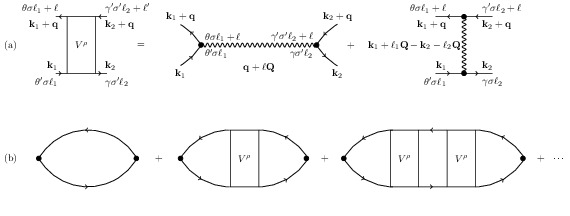The fundamental properties of all materials---such as their colour, hardness, or electrical conductivity---are determined, in the end, by the laws of quantum mechanics. Quantum materials are different because quantum mechanics adds an extra twist to the usual story. This can happen for many reasons, for example because of confined geometry, topological effects, or collective behaviour, but ultimately it always comes back to the fact that electrons (and sometimes atoms!) behave like waves, and not particles.
In recent years, I have been working with students and collaborators on developing models for two families of quantum materials: high temperature superconductors and strontium titanate interfaces.
- If you want to know more, an almost-complete list of my papers can be found here.
- Here is the talk I was supposed to give at the 2020 APS March Meeting in Denver, before it was cancelled.
|
 Ferroelectrics are electrical insulators that have a persistent polarization. Because the polarization can be switched with an electric field, ferroelectrics have been used, for example, in non-volatile computer memory (so-called FeRAM). Ferroelectrics tend to break up into domains, which is largely seen as an unavoidable nuisance that degrades device performance. The image on the right shows a simulated ferroelectric slab. The red and blue regions correspond to two different domains, and the arrows indicate the direction of polarization. Remarkably, the domain wall (the white line) is conducting and can be maniputated by applying an electric field or by strain. Recently, conducting domain walls have been proposed as possible reconfigurable circuit elements. The end-goal is circuits that function as both non-volatile memory and cpu. This has potential applications, for example, in neuromorphic computing. As a theoretical physicist, I want to understand the microscopic physics underlying conducting domain walls: Why do they behave as they do? What new functionalities can we can hope to find? Ferroelectrics are electrical insulators that have a persistent polarization. Because the polarization can be switched with an electric field, ferroelectrics have been used, for example, in non-volatile computer memory (so-called FeRAM). Ferroelectrics tend to break up into domains, which is largely seen as an unavoidable nuisance that degrades device performance. The image on the right shows a simulated ferroelectric slab. The red and blue regions correspond to two different domains, and the arrows indicate the direction of polarization. Remarkably, the domain wall (the white line) is conducting and can be maniputated by applying an electric field or by strain. Recently, conducting domain walls have been proposed as possible reconfigurable circuit elements. The end-goal is circuits that function as both non-volatile memory and cpu. This has potential applications, for example, in neuromorphic computing. As a theoretical physicist, I want to understand the microscopic physics underlying conducting domain walls: Why do they behave as they do? What new functionalities can we can hope to find?
Want to see what my graduate students have to say about conducting domain walls? Have a look here, here and here.
|


